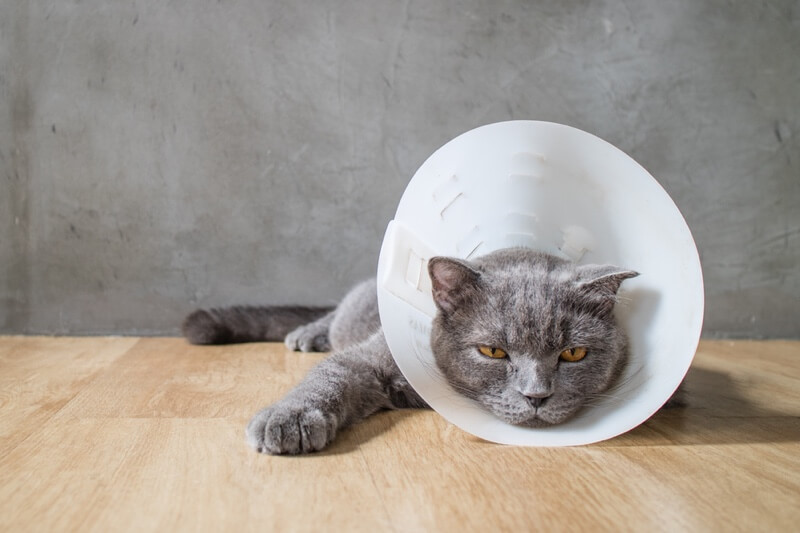
Nobody wants to think about their feline friend getting hurt, but it happens. Sometimes curiosity gets the best of our cats, and they put their noses where they don’t belong or get stuck in a tight space. Learn about the five most common cat injuries and what you should do if one happens to your cat.*
Swallowed Objects
Unlike dogs who seem to eat anything from rocks in the yard to socks pinched from the hamper, cats have a reputation for being finicky eaters. However, cats still end up swallowing things they shouldn’t, like torn off pieces of a toy, bits of yarn or string found on the floor, or food wrappers with a tasty scent. Sometimes a swallowed object will go right through your cat without a problem, but this is not always the case
Obstructions
The object can get stuck and cause an obstruction in the digestive tract. This can lead to severe symptoms, including vomiting, diarrhea, or constipation. If you suspect your cat has an obstruction, you should visit your veterinarian as soon as possible. Your veterinarian can determine the best course of treatment, which might include surgery to remove the object.
Choking
A swallowed object can cause choking in which case you might need to perform a cat version of the Heimlich maneuver by following these steps:
- Hold the cat in one hand with their head facing down.
- Make a fist with the other hand and place it below the bottom rib.
- Push upwards with a quick movement to expel the object.
You should head right to the veterinarian afterward to have your cat evaluated.
Poison Exposure
In addition to swallowed objects, cats can nibble on toxic plants or ingest poisonous substances, such as human medications, cleaning supplies, antifreeze, or pesticides. Be sure to keep potentially harmful things stored safely out of paw’s reach. Check 101 Household Pet Dangers for a list of possible pet hazards and tips on prevention.

Bite Wounds
All cats should be kept inside to help protect them from injuries like bite wounds as well as contagious diseases and parasites. However, they can still get outside unexpectedly and get bitten by an animal. Bite wounds can also happen during altercations with other pets in the home or if wildlife slips inside the house. For instance, a squirrel can tumble down the chimney and get in through an open flue or a bat could fly in through a broken attic screen.
If your cat has a bite wound, you should visit the veterinarian even if it seems like a minor injury. Bite wounds need to be cleaned and treated properly to help avoid infection. In some cases, sutures might be needed to close the wound. Unvaccinated pets and wild animals can also carry rabies, which is transmitted through the saliva. Your veterinarian can assess the situation and determine the possibility of rabies.
Fractured Teeth
A fractured tooth is a common injury for cats, but it can be difficult to detect. Fractures can occur below the gum line where they aren’t visible. Cats are also infamous for masking or hiding their symptoms. If you notice that your cat is having trouble eating, chewing on one side of the mouth, or drooling, you should consult your veterinarian.
Tooth fractures can happen in an accident, such as getting hit by a car or falling out of a window, which can happen when a cat pushes up against a loose screen. (Be sure to check your window screens, especially in warm weather months when windows tend to be open). They can also happen if your cat bites or chews on something hard.
Treatment will vary depending on the location and severity of the fracture. Your veterinarian may just need to file down the rough edges of the tooth to prevent irritation in the mouth. In more serious instances, extraction of the tooth or other dental procedures might be needed to resolve the issue. Learn more about dental care for cats.

Abscesses
An abscess starts out as a swollen lump that eventually bursts into an open wound, which can have pus and blood draining from it. It can be accompanied by other symptoms, including fever, lack of appetite, and increased irritability. The most common cause of an abscess is a bite wound since it can harbor bacteria from the biter’s saliva.
If your cat has an abscess, you need to take them to the veterinarian. Treatment typically includes clipping the fur around the area and cleaning the abscess. It may need to be lanced to release excess fluids. A temporary drain may also need to be put in place to keep fluid from building back up. Antibiotics and other medications could be needed to prevent infection and manage pain.
Lacerations
Lacerations can happen for a number of reasons, from stepping on a sharp object or piece of glass to a fight with another animal. If your cat has a laceration that is bleeding, you should apply pressure using gauze, a clean cloth, or soft washcloth until it stops. Once the bleeding is under control, you should contact your veterinarian.
Treatment for a laceration will depend on the severity of the injury. Usually, it consists of trimming the fur around the area, carefully cleaning the wound, and suturing it closed, if necessary. Cleaning and suturing may be done under general anesthesia. Your veterinarian may also prescribe antibiotics to prevent infection.
Tips to Care for an Injured Cat
If your cat gets injured, keep these tips in mind:
- Don’t panic. You’ll need a clear head to figure out the best way to help your cat. Cats are also sensitive to human emotions, so if you stay calm, your cat will be more likely to stay calm too.
- Handle the cat carefully. Cats who are in pain, stressed, or afraid might try to scratch, bite, or run off when you try to pick them up. In addition, they might jump out of your arms and risk further injury. Ask a friend for a second set of hands if you need them. You can also wrap the cat up gently in a towel or small blanket while leaving the injured area exposed if possible.
- When in doubt, get help. In some cases, it will be clear that your cat needs medical treatment. In others, you might wonder what to do. If you are uncertain, call your veterinarian or local animal hospital for guidance.
You should make sure you have the phone numbers to your veterinarian and a 24/7 animal hospital stored on your phone so you can call quickly. It is also a good idea to save the phone number for the ASPCA Animal Poison Control Center in case of a poison emergency. You can call them at 888-426-4435 for help 24 hours a day, 365 days a year. A $65 consultation fee may apply when you call, but a portion of that is covered if you have an ASPCA Pet Health Insurance plan.

Being Prepared for Cat Injuries
It’s impossible to prevent all cat injuries, but you can do a few things to prepare for an emergency. For instance:
- Get a cat first aid-kit. You can purchase a pre-made first aid kit or put one together on your own. You will want to fill it with items such as bandages, gauze, saline solution, cotton balls, and tweezers. The infographic in this article can help you stock your kit.
- Talk with your veterinarian. The next time you see your veterinarian, ask them about how to handle an emergency situation for your cat. Also, find out what the protocol is if your cat gets hurt when they are closed.
- Sign up for pet insurance. Some people think that cats don’t need coverage, but they can get hurt or sick when you least expect it. Pet insurance can help you provide your cat with the best care possible with less worry about the cost.
With ASPCA Pet Health Insurance, you can also add preventive care coverage at a low additional cost to get reimbursed for yearly exams, vaccines, dental cleanings, and other things that can help your pet live a long and healthy life. Get a free quote for your cat today!
* Internal Claims Data, 2016
(opens new window)
Helpful resources for pet parents
Browse categories

Browse Categories
(opens new window)



